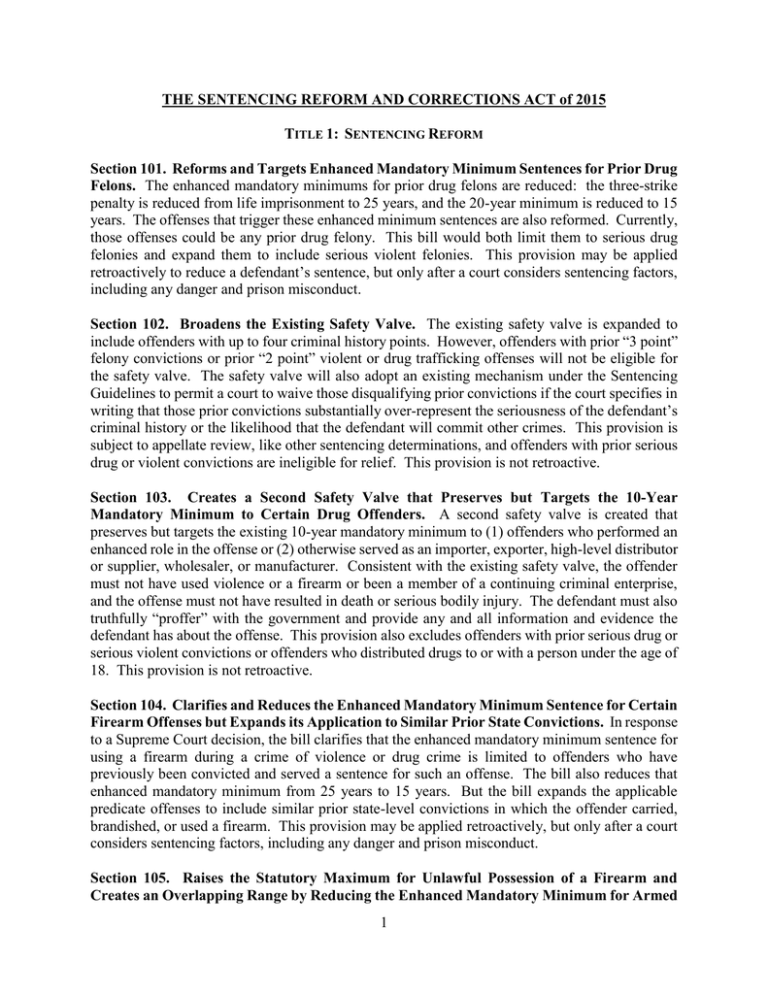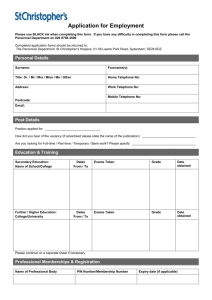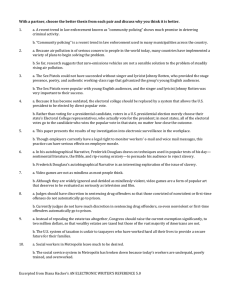1 THE SENTENCING REFORM AND CORRECTIONS ACT of 2015
advertisement

THE SENTENCING REFORM AND CORRECTIONS ACT of 2015 TITLE 1: SENTENCING REFORM Section 101. Reforms and Targets Enhanced Mandatory Minimum Sentences for Prior Drug Felons. The enhanced mandatory minimums for prior drug felons are reduced: the three-strike penalty is reduced from life imprisonment to 25 years, and the 20-year minimum is reduced to 15 years. The offenses that trigger these enhanced minimum sentences are also reformed. Currently, those offenses could be any prior drug felony. This bill would both limit them to serious drug felonies and expand them to include serious violent felonies. This provision may be applied retroactively to reduce a defendant’s sentence, but only after a court considers sentencing factors, including any danger and prison misconduct. Section 102. Broadens the Existing Safety Valve. The existing safety valve is expanded to include offenders with up to four criminal history points. However, offenders with prior “3 point” felony convictions or prior “2 point” violent or drug trafficking offenses will not be eligible for the safety valve. The safety valve will also adopt an existing mechanism under the Sentencing Guidelines to permit a court to waive those disqualifying prior convictions if the court specifies in writing that those prior convictions substantially over-represent the seriousness of the defendant’s criminal history or the likelihood that the defendant will commit other crimes. This provision is subject to appellate review, like other sentencing determinations, and offenders with prior serious drug or violent convictions are ineligible for relief. This provision is not retroactive. Section 103. Creates a Second Safety Valve that Preserves but Targets the 10-Year Mandatory Minimum to Certain Drug Offenders. A second safety valve is created that preserves but targets the existing 10-year mandatory minimum to (1) offenders who performed an enhanced role in the offense or (2) otherwise served as an importer, exporter, high-level distributor or supplier, wholesaler, or manufacturer. Consistent with the existing safety valve, the offender must not have used violence or a firearm or been a member of a continuing criminal enterprise, and the offense must not have resulted in death or serious bodily injury. The defendant must also truthfully “proffer” with the government and provide any and all information and evidence the defendant has about the offense. This provision also excludes offenders with prior serious drug or serious violent convictions or offenders who distributed drugs to or with a person under the age of 18. This provision is not retroactive. Section 104. Clarifies and Reduces the Enhanced Mandatory Minimum Sentence for Certain Firearm Offenses but Expands its Application to Similar Prior State Convictions. In response to a Supreme Court decision, the bill clarifies that the enhanced mandatory minimum sentence for using a firearm during a crime of violence or drug crime is limited to offenders who have previously been convicted and served a sentence for such an offense. The bill also reduces that enhanced mandatory minimum from 25 years to 15 years. But the bill expands the applicable predicate offenses to include similar prior state-level convictions in which the offender carried, brandished, or used a firearm. This provision may be applied retroactively, but only after a court considers sentencing factors, including any danger and prison misconduct. Section 105. Raises the Statutory Maximum for Unlawful Possession of a Firearm and Creates an Overlapping Range by Reducing the Enhanced Mandatory Minimum for Armed 1 Career Criminals. The statutory maximum for the unlawful possession of a firearm by a convicted felon and certain other offenders is increased from 10 to 15 years. It also eliminates a significant gap in current sentencing laws by reducing the enhanced mandatory minimum for armed career criminals from 15 to 10 years. This provision may be applied retroactively, but only after a court considers sentencing factors, including any danger and prison misconduct. Section 106. Retroactive Application of Fair Sentencing Act. The Fair Sentencing Act of 2010 reduced the disparity in sentencing between crack and powder cocaine. This provision ensures the retroactive application to offenders sentenced under those provisions before they were modified. Section 107. New Mandatory Minimum for Interstate Domestic Violence Section 108. New Mandatory Minimum for Certain Export Control Offenses Section 109. Report and Inventory of All Federal Criminal Offenses TITLE 2: THE CORRECTIONS ACT Section 202. Recidivism Reduction Programming and Productive Activities. This section requires BOP to make statistically validated recidivism reduction programming available to all eligible prisoners within six years. As an incentive for successfully completing recidivism reduction program, eligible inmates may receive time credit of up to five days for each period of 30 days of programming that they successfully complete. Inmates classified as low risk may receive an additional credit of up to five days for each period of 30 days of program completion. Inmates serving sentences for a second or subsequent federal offense and those with 13 or more criminal history points under the sentencing guidelines are ineligible for time credits. Inmates serving sentences for certain offenses are excluded, including crimes of terrorism and violence. Section 203. Post-Sentencing Risk and Needs Assessment System. The Attorney General is required to develop a risk and needs assessment system that will determine the recidivism risk of all federal inmates and classify inmates as having a high, moderate, or low risk of recidivism. The assessment system must also identify each inmate’s programmatic needs and identify appropriate programming. The system must measure indicators of progress such that each inmate (other than those already classified as low risk) has a meaningful opportunity to progress to a lower risk level during the time of the inmate’s incarceration through changes in dynamic risk factors, and that each inmate on prerelease custody (other than those already classified as low risk) has a meaningful opportunity to progress to a lower risk classification through changes in dynamic risk factors. Section 204. Prerelease Custody. This section allows prisoners to serve an amount of time equal to the credit they have earned for recidivism reduction programming in prerelease custody, provided that the prisoner’s most recent risk assessment determined that the prisoner was low or moderate risk and, if moderate risk, that the prisoner’s risk of recidivism has declined. It provides that a prisoner permitted to spend a portion of the prisoner’s sentence in prerelease custody as a result of completing recidivism reduction programming may spend such time in a residential reentry center, on home confinement, or on community supervision. Inmates placed in home confinement shall be subject to monitoring and be required to remain in their residence, with exceptions for employment and other specified activities. BOP may revoke a prisoner’s prerelease 2 custody and require the prisoner to serve the remainder of the prisoner’s term of incarceration in prison if the prisoner violates the conditions. Section 205. Reports. This section requires reports about best practices and notice for veterans. Section 206. Additional Tools. This section requires presentence investigation reports to include information about the defendant’s history of substance abuse and addiction, the defendant’s prior service in the Armed Forces, and a detailed plan to reduce the defendant’s likelihood to abusing drugs or alcohol, address the defendant’s risk of recidivism, and prepare the inmate for reentry. Section 207. Eric Williams Correctional Officer Protection Act. This section permits officers and employees of BOP to carry oleoresin capsicum spray (pepper spray). BOP officers and employees are required to complete a training course prior to being issued pepper spray, and may use pepper spray to reduce acts of violence. Section 208. Promoting Successful Reentry. This section requires the Attorney General to submit a report evaluating best practices for reentry, and to carry out reentry demonstration projects in judicial districts in consultation with the Administrative Office of the Courts. Section 209. Parole for Juveniles. The Supreme Court has ruled that the Constitution requires that juveniles convicted as adults and sentenced to life terms must be eligible for parole. The bill creates a system whereby such juveniles in the federal system will be eligible to seek parole after they have served 20 years of their sentence. A judge would apply a range of specified factors in deciding whether to grant parole. If parole were denied, the inmate could apply twice more for parole after five years had elapsed after denial. The provision applies as well to juveniles sentenced as adults to terms longer than 20 years. Section 210. Compassionate release. The bill would allow certain individuals with no record of violence who are older than 60, as well as terminally ill offenders and those in nursing homes who have served a large portion of their sentences, to be released from prison. Section 211. Juvenile sealing and expungement. This section permits nonviolent juveniles who are tried as juveniles in federal court, other than for misdemeanor domestic violence offenses, to obtain sealing or expungement of their convictions in certain circumstances. The goal is to enable youthful offenders who live a crime free life to seek employment without regard to earlier errors in their life. Section 212. Juvenile solitary confinement. The bill would impose limitations on the use of solitary confinement for juveniles housed in federal prison. Section 213. Accuracy of federal criminal records. Under this section, the Attorney General would establish and enforce procedures for individuals who are to undergo background checks for employment to challenge the accuracy of their federal criminal records, in particular, of arrests without dispositions. 3








